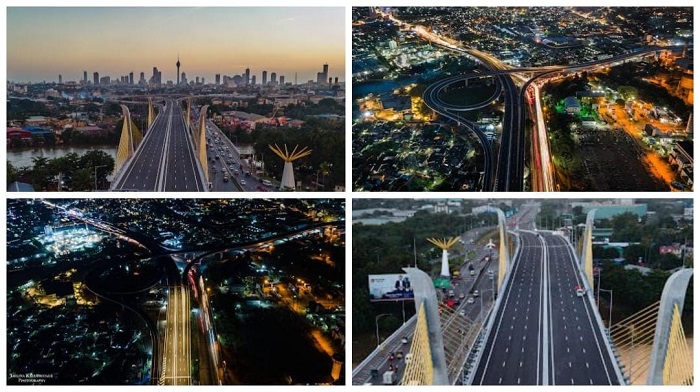
The New Kelani Bridge constructed with advanced technology culminating in several milestones in transport technology in Sri Lanka has been named “Golden Gate Kalyani” (Kalyani Rani Pivisuma).
Chief Government whip and Minister of Highways Johnston Fernando has stated that the bridge will be declared open by President Gotabaya Rajapaksa and Prime Minister Mahinda Rajapaksa tomorrow (24) at 6 pm.
Issuing a statement yesterday, he stated that the bridge itself consists of two sections – the extradosed bridge section over the river, and the steel box girder viaduct section over the existing roadway.
“Both technologies are used for the first time in Sri Lanka. The extradosed design enabled the bridge to have the widest span without piers in any bridge in Sri Lanka. As no piers needed to be constructed on the river bed, there is no impact on the water flow or ecology of the river itself. The steel box girder technology enabled the viaduct section to be constructed with narrower curves to optimize space, and quicker construction to optimize resources with minimum disruption to traffic,” he explained.
The Minister further said the six-lane bridge extends southwards from the Colombo-Katunayake Expressway and divides towards the Port Access Road ending at the Ingurukade Intersection and the Baseline Road ending at the Orugodawatte Intersection.
Following the understanding of the need for a new bridge that could cater to the increased volume of traffic with the opening of the Colombo-Katunayake expressway, the bridge was designed in 2012 and its feasibility study was conducted in 2013, and agreements were signed in 2014 when Mahinda Rajapaksa was the President and the Minister of Highways.
The bridge has six lanes from the end of the Colombo – Katunayake Expressway to the Bandaranaike Roundabout and will be four lanes from there on to the Orugodawatta, Ingurukade Junction, and the Port entrance.
The length of the bridge section across the Kelani River is 380 meters. The bridge is being constructed in two stages. The first package, the steel output bridge section, is at a cost of Rs. 31,593 million, while the second stage, the concrete suspension bridge section, is at a cost of Rs. 9,896 million.
Minister Fernando said that his Ministry officials have planted trees that could absorb particulate matter, black carbon and dust, while tolerating heat, along the new bridge and connecting roads including the Kelanitissa circular road and the road to the bridge from the Orugodawatte junction which is considered a highly populated urban area.
Officials of the Department of National Botanical Gardens have recommended that trees that could work as “lungs” of an ecosystem because they absorb carbon dioxide and emit oxygen should be selected for the purpose. Accordingly, they have selected trees such as Koboneela (Bauhinia purpurea), the Golden shower or Ehala (Cassia fistula), May Mara (Delonix regia), Robarosiya (Tabebuia Rosea), Kaha Mara (Poinciana regia) Rat Mal (Rhododendron arboretum), Mee (Madhuca longifolia), Kumbuk (Terminalia arjuna), Na tree (Mesua ferrea) the Ceylon ironwood, Araliya (Plumeria) Magul Karanda (Pongamia pinnata), Nuga (Ficus benghalensis) and Murutha (the queen of flower tree -Lagerstroemia speciosa). An underground pipe system has been laid down to provide water to the trees continuously, he added.
Minister Fernando further said that the new bridge would be the main attraction that would amplify the beauty of the commercial capital of the country and also the exquisiteness of the Kelani River. Engineers have illuminated the new bridge using new technologies of lighting systems from other countries to make it a local and foreign tourist attraction. (NewsWire)